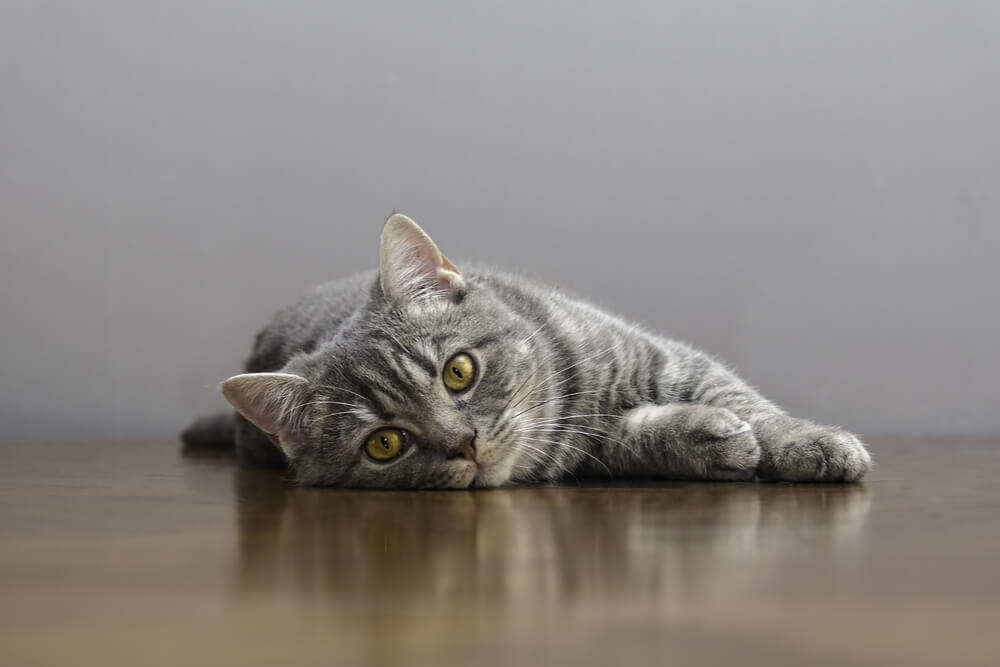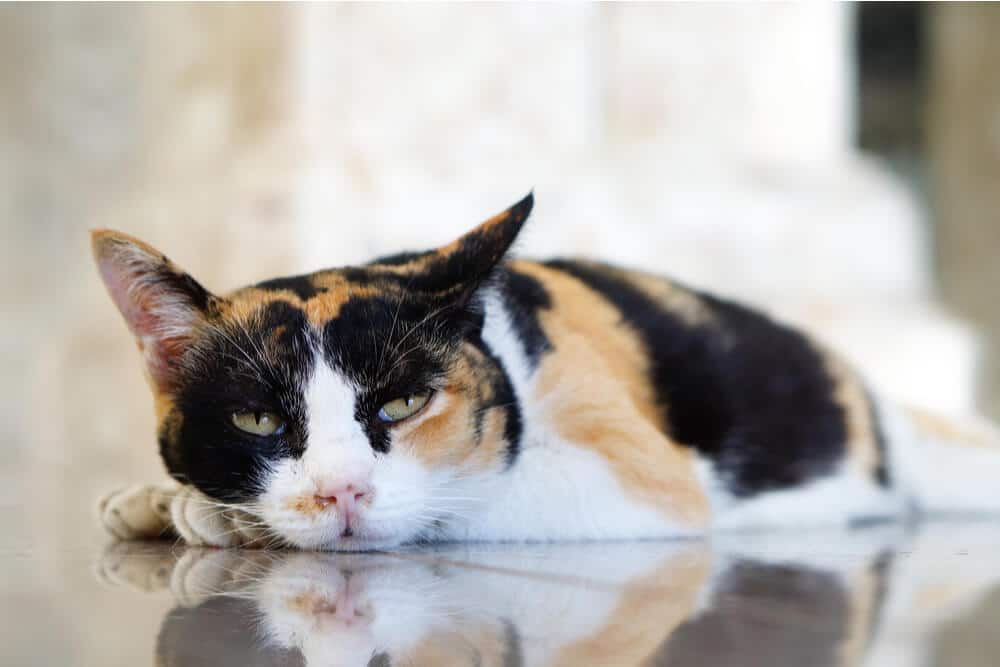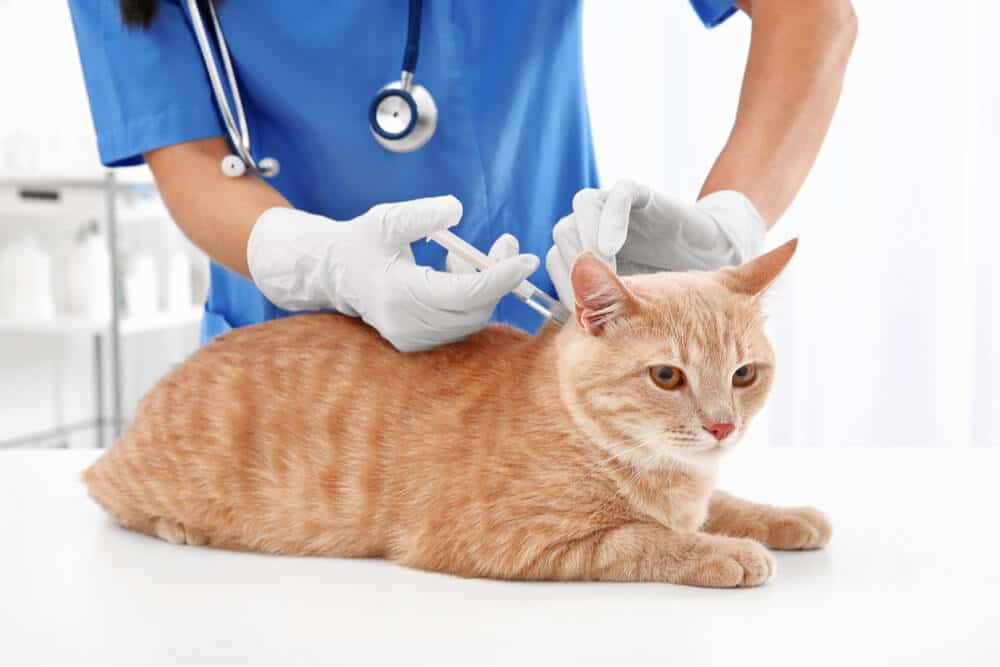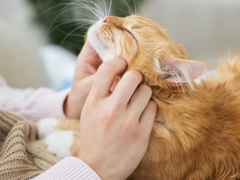
What Is Feline Aids?
Feline AIDS (Feline Acquired Immune Deficiency) Syndrome) is a disease caused by FIV (Feline Immunodeficiency Virus). As the name suggests, the syndrome has parallels with Human AIDS, caused by the Human Immunodeficiency Virus (HIV).
Quick Overview: Feline Aids
 Other Names: Feline Immunodeficiency Virus, Feline Aids
Other Names: Feline Immunodeficiency Virus, Feline Aids
 Diagnosis: FIV blood tests that detect FIV antibodies.
Diagnosis: FIV blood tests that detect FIV antibodies.
 Requires Ongoing Medication: No
Requires Ongoing Medication: No
 Vaccine Available: While a vaccine is available, it is not 100% effective and will cause a cat to be positive on FIV blood tests. Thus, prevention of FIV through reducing risk by keeping a cat indoors and limiting exposure to stray cats is preferred over vaccination.
Vaccine Available: While a vaccine is available, it is not 100% effective and will cause a cat to be positive on FIV blood tests. Thus, prevention of FIV through reducing risk by keeping a cat indoors and limiting exposure to stray cats is preferred over vaccination.
 Treatment Options: There is no treatment for FIV or feline aids specifically. Some antiviral medications have been tried but have variable results. Management focuses on regular health checks and treating secondary infections early if they develop.
Treatment Options: There is no treatment for FIV or feline aids specifically. Some antiviral medications have been tried but have variable results. Management focuses on regular health checks and treating secondary infections early if they develop.
 Home Remedies: None
Home Remedies: None
How Common Is Feline Aids?
Feline AIDS is common all around the world, but its prevalence varies from location to location. For example, in a 2017 study of cats in the USA and Canada, 3.6% of cats were positive. Cats that present as sick animals have a higher chance of being FIV positive (e.g. in the 2017 study, nearly 10% of cats with oral disease were FIV positive).
Similarly, in the UK, between three to six percent of healthy cats are positive, while sick cats tested while visiting vet clinics have a higher prevalence of 12 -18%.
FIV infection is more common in intact (uncastrated) male cats that have a history of deep bite wounds or abscesses, or that spend time outside.
What Causes Feline Aids?
Feline AIDS is caused by Feline Immunodeficiency Virus (FIV). FIV is a retrovirus belonging to the lentivirus genus. The virus causes generalised immunosuppression, depleting specific white blood cells (T-helper cells).
This depletion in white blood cells has a strong negative effect on the cat’s immune system, making the cat more susceptible to infections and illness.
How Is Feline Aids Transmitted?
The FIV virus causing Feline AIDS is mainly passed from cat to cat in the saliva via bite wounds.
The virus may also be transmitted from pregnant females to their offspring in the womb, or in early life via the milk. Rarely, the infection may transmit between two cats in the same household that have no history of fighting or biting each other.
Also Read:Â What To Know When Adopting A FIV-Positive Cat
Is Feline Aids Contagious to Humans?
No. FIV, causing Feline AIDS, and HIV, causing Human AIDS, are both lentiviruses, but humans cannot be infected by FIV, nor can cats be infected by HIV.
What Are the Symptoms of Feline Aids?

Cats with Feline AIDS exhibit symptoms related to immunosuppression, including lethargy, inappetence, and fever.
The symptoms of Feline AIDS are linked to immunosuppression, which enables secondary infection by other disease-causing agents.
Typical Early Signs Include:
- Lethargy
- Inappetence
- Fever
- Lymphadenopathy (enlarged lymph nodes)
In the later stages of the disease, a range of serious signs of disease are seen, including:
- Gingivitis and stomatitis with halitosis, drooling, and pain when eating
- Weight loss
- Abscesses
- Respiratory signs (such as wheezing and dyspnea)
- Neurological signs (such as behavioral changes and seizures)
- Ocular issues
- Digestive disorders
In addition to these issues, feline AIDS is connected to a wide variety of other intercurrent infections.
Cat FIV Stages
Typical early signs include:
- The Primary Phase, this stage includes the first two to four months after infection with the virus. Some infected cats are asymptomatic, while other FIV cats show short-term signs of illness involving malaise, pyrexia, and possibly generalised lymph node enlargement. Most FIV positive cats recover from this early phase.
- The Second Phase, sometimes known as the latent stage. During this stage, cats show no signs of illness, living healthy lives for months or years.
- The Third Phase known as the Feline Acquired Immunodeficiency Disease stage (FAIDS). The signs shown may depend on where in the cat’s body the virus is active.
Infection of the nervous system can lead to neurological signs or behavior change, infection of the digestive system can lead to chronic diarrhoea. The most prominent signs are usually linked to the overall immunodeficiency caused by the virus, with signs including weight loss, inappetence, fever, lymphadenopathy (enlarged lymph nodes) and gingivitis.
Other typical problems include upper respiratory tract signs such as rhinitis (inflammation of the lining of the nose) and conjunctivitis, as well as repeated problems with skin infections. Affected cats are also at a higher risk of developing cancer (e.g. lymphoma) as well as multiple other infections that would not cause significant problems in cats with healthy immune systems.
How Long Do Cats Live With Feline Aids?
The prognosis for cats that are FIV positive, but without showing signs of illness, can be very good, with some cats living for almost as long as cats that are FIV negative. However, cats that have developed Feline AIDS, with severe signs of disease, have a poorer prognosis.
Their remaining lifespan may be just a few months, but with the right treatment, this may be extended to several years.
How Is FIV Diagnosed?
Feline Immunodeficiency Virus is diagnosed by carrying out a blood test, with various options available.
Most tests that are carried out in-house by veterinarians are antibody tests, based on enzyme-linked immunosorbent assay (ELISA) or immunochromatographic (IC) techniques to detect FIV antibodies.
These tests are accurate, with high specificity and sensitivity. They can be processed rapidly, with the cat carer often waiting to hear the result within minutes. Often combination tests are used, with the blood sample being checked for Feline Leukemia Virus (FeLV) at the same time as FIV, which makes logical sense since the signs of both viral infections can be similar.
Positive results may be followed up by sending samples to external laboratories, which offer more specialised tests.
These are often used to doubly confirm a positive or negative diagnosis. Specialised tests include immunofluorescence (IFA) and western blot tests for the detection of antibodies to FIV, and virus isolation and polymerase chain reaction (PCR) for the detection of the virus itself.
Virus isolation is sensitive but needs specialised facilities, making it costly and slow compared to other diagnostic tests, so it’s rarely used.
PCR tests are now widely available, detecting the FIV nucleic acids. These are especially useful in the diagnosis of FIV infection in young kittens where antibodies derived from the infected mother cat may interfere with tests that use antibodies to make the diagnosis.
Feline Aids Test
Feline AIDS describes the disease caused by the FIV virus, so there is no specific test for AIDS. If a cat with signs of AIDS has a positive test result for FIV, then they would be classified as being positive for Feline AIDS.
How To Treat Feline AIDS
Cat carers should work closely with their DVM veterinarian to devise an individualised treatment strategy, but some of the following treatments may be used.
- Zidovudine (AZT) blocks the viral reverse transcriptase enzyme, inhibiting infection of new cells with the virus, but it cannot decrease viral multiplication in cells that are already infected. AZT is most useful as a way of preventing cats from developing full-scale Feline AIDS, as well as for treating cats with neurologic disease or gingivostomatitis.
- Interferon has been used, with its immunomodulatory and antiviral effects improving survival rates in some studies, while other studies have had less convincing results.
- Lymphocyte T cell immune modulator (LTCI) stimulates the immune system and may be able to improve clinical signs and reduce the viral burden in affected cats.
- Insulin, administered intra-nasally, has been linked to improvement in some cats affected with neurological signs of Feline AIDS.
- General supportive therapy has a strong role to play, using antibiotics for bacterial infections, avoiding immunosuppressive medication like glucocorticoids, and perhaps erythropoietin to stimulate red blood cell production in anaemic cats. Blood transfusions may also be recommended in some cases.
How To Prevent Feline AIDS
Indoor cats, kept as single pets, have no risk of picking up FIV or Feline AIDS. Neutering plays a role in prevention, as neutered male cats are 80% less likely to fight compared to entire male cats.
Spread is by direct cat to cat contact by fighting, rather than via the environment (e.g. via food bowls or a litter box) or aerosols. The FIV virus is easily destroyed using common detergents and disinfectants, and it does not live for long in the environment.
If a new cat is introduced to a household, it makes sense to carry out an FIV test first.
Cats that are known to be FIV positive should be kept indoors to prevent the spread of infection to other cats, as well as to reduce exposure of themselves to other infectious diseases. Effective parasite control, regular vaccination and high-quality nutrition are all important to reduce the onset of signs linked to a poor immune system.
Feline AIDS Vaccine

At-risk cats may be given the feline AIDS vaccine, which addresses two types of FIV.
A whole virus, adjuvant vaccine against FIV is licensed in the United States. This vaccine contains inactivated subtypes A and D. Efficacy is variable. The vaccine does not contain subtype B, which is one of the predominant subtypes found in the USA. Inconsistent results have been found in challenge studies.
FIV vaccine is considered a non-core vaccine by the American Association of Feline Practitioners (AAFP) and may be reserved for cats with at-risk lifestyles (e.g. those living with FIV-positive housemates, outdoor cats that are prone to fighting).
Cats over 8 weeks can be vaccinated, using two doses given subcutaneously 2-3 weeks apart, followed by annual booster vaccinations. Cats vaccinated with the FIV vaccine will test positive on serologic tests, so they need to be identified (eg with a microchip) so that it is known that they are vaccinated, and they are not mistaken as being FIV positive due to virus exposure.
Feline AIDS is a complex disease that’s now well understood.
The diagnosis of an FIV positive blood test is no longer a reason to euthanase a healthy cat, as many positive cats can have long and healthy lives.
Frequently Asked Questions
How do cats get feline aids?
The FIV virus causing Feline AIDS is mainly passed from cat to cat in the saliva via bite wounds. Feline aids may also spreads through other forms of contact with an infected cat's bodily fluids, such as blood, semen, or milk, however this is less common.
Can feline aids be transmitted to dogs?
Feline aids cannot be transmitted to humans or dogs








I have a feral male cat named Scruffy who I have befriended and been feeding (and keeping company inside from time to time) for the past 13 years. He has a female friend and they had two kittens before I was able to get her and him neutered (both are neutered now, as is their daughter – the boy kitten disappeared at a young age). I am sure he has cat aids, as he got in many fights as the big male in our neighborhood. He’s a good cat who these days mostly sleeps, but his breathing sounds awful and I wanna try to help him without taking to a vet. I say this cause there was another stray male who came on the property two years ago, who was just starting to be friendly, but I noticed one day he was limping badly. I trapped him and took him to a animal emergency center asking them to look into the limp and while there also neuter him. They hit me with a $475 bill, and forced me to submit and alow them to put him down not because of the limp, but because their tests (I didn’t ask for) showed the cat had feline aids. I’m not doing this to Scruffy. Any suggestions to help him breath more comfortably?
Hi Victor. I think this is about remembering that you are the one who makes the decisions for Scruffy, and they should not be allowed to force you to agree to euthanase him. I am reluctant to make suggestions about how to help him to breathe more comfortably as I am not confident that these will a huge difference, while I would be confident that engaging with a veterinarian *will* make a big difference. At a simple level, you can make sure that he does not have discharges accumulating around his nostrils, so that his airways are clear: if there is yellow, brown or red crusty stuff here, clean this off twice daily, using cotton wool or cotton buds, soaked in mildly salty water (a teaspoonful of salt in a pint of water). But other than this, it is difficult to do much to help on your own. However, it would make a difference to know for sure if he is FIV positive or negative, and if he is FIV positive, there are a number of anti viral medications listed in the article which may help. Additionally, he may have a bacterial lung infection (whether he is FIV positive or negative) and this may respond very well indeed to a course of antibiotics. They may make a completely different diagnosis (such as laryngeal paralysis, or many other possibilities) and they may suggest other ways of helping him. The key is that you – and Scruffy – are entitled to choose what is best for you both on a “spectrum of care” – you may wish to choose the least expensive, minimally interventionist approach, or you may want the most expensive, most complex approach. That’s up to you, and the vet ought to respect your choice. The only time when a vet might strongly recommend euthanasia would be if a cat was genuinely suffering significantly with no prospect of any relief, and it does not sound as if this is the case with Scruffy. I hope this helps. And please, get back to us in due course and let us know how you and Scruffy get on with this. Remember, a diagnosis of Feline AIDS is not a death sentence: with the right treatment, many infected cats can have a good quality of life for several years.
I have an outdoor stray cat that I take care of he has aides and he druels and his gums are red and a little bleeding in bottom gums. The nose drops thick stuff and it smells bad. He can only eat soft can food is he in late stages if aides and is he suffering.. he is almost 12 yrs. Old
So sorry to hear about this, June! Is there any way you could get this cat some veterinary care? A local rescue might be able to trap the cat to offer him some relief.
I pick him up and pet him daily he is very freindly and always has been since he was a year old I have been feeding him. I give him oral antibiotics amoxsilan. he druels bad and I wipe his mouth 3 times daily and he doesn’t like me to because his gums hurt. he eats 3 times daily and runs around in the yard. can’t let him in the house near my other 3 cats. he was diagnosed over a year ago. do you think he is suffering?. I love him and he is so freindly.and sweet. He has a cat house on our covered patio with blankets to keep him warm in the winter. what other antibiotic can I get for him to heal his bottom gums?
Sorry, June. I’m not a vet, so I wouldn’t able to provide recommendations on another antibiotic. I’d recommend talking to a local vet clinic or rescue to see if they can help you out.
I’m feeding a stray female near my house (hoping to TNR her [which includes a FIV test] ). If she has FIV, could it transmit to my indoor cat via the food bowl? (I wash the food bowl immediately with hot water & dish soap as soon as I bring it in, and it never gets near my indoor cat; usually he’s in another room when I bring the bowl inside.)
Fomite transmission (i.e. on objects such as food bowls) is not an important route for FIV as the virus quickly loses infectivity outside the host and is susceptible to all commonly used disinfectants. By far the most common mode of transmission is via bite wounds from infected cats. That said, I would probably avoid food bowl sharing at all, to be absolutely triple safe. But really, any risk is miniscule. Hope this helps.
I have a FIV male cat and I am new at this but I know that he will be just fine and just as well as can be expected.
I just found your site and have found it to be very uplifting.
Glad you found it uplifting! 🙌
My cat lasted 4 1/2 yrs with F L V I got her from a cat shelter at 6 months old her siblings lasted only a few months this one 4 1/2 yrs then suddenly it went so quick out of the blue well I really like to wonder if her rabies shot did her in I’m not sure during her appointment exam
She took a quick turn. Her gums were white and I took her to vet spent money on liquid meds but she only grew weaker. I had no clue it happened so fast I had to put her to sleep I was so mad at myself for not recognizing her issue anemia set in 3 weeks has gone by since her passing I’m feeling less sad now she sent me a cat cloud from the afterlife though